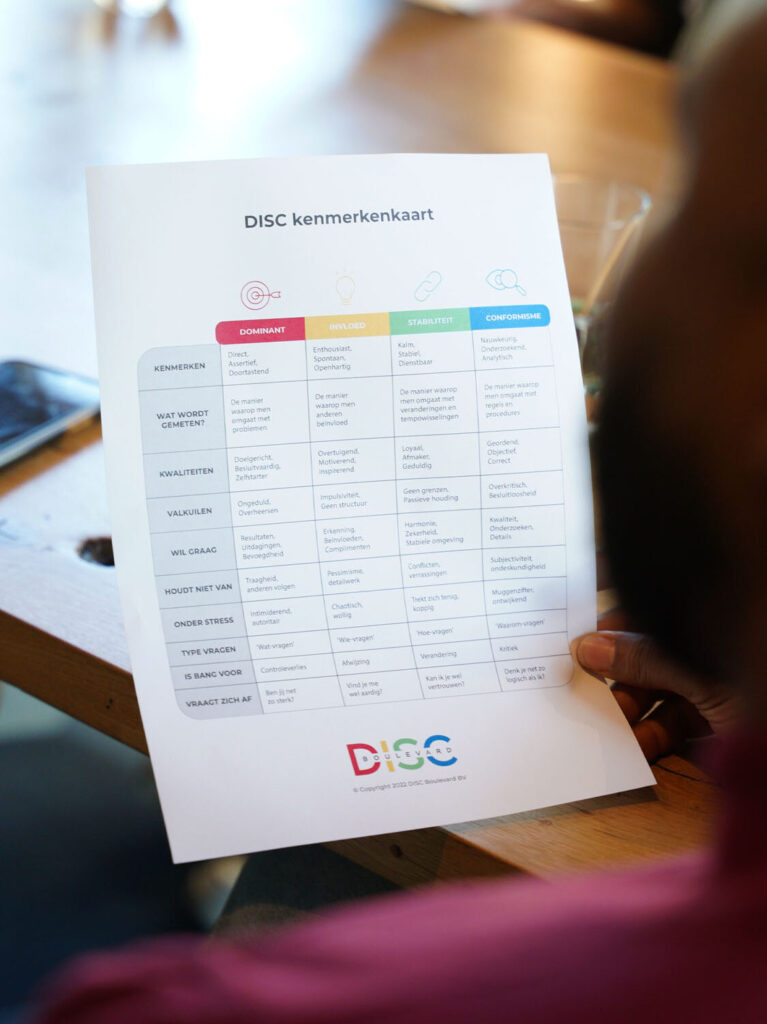Collaboration is key in any organisation. But that sometimes sounds easier said than done. In this blog, we look at the different team roles that match the DISC behavioural styles. Where does the strength of each behavioural style lie?
The DISC model is a key to insights
The DISC model provides valuable insights into the four different behavioural styles of dominance, influence, stability and conformism. By understanding the different behavioural styles, team members can collaborate more effectively and work more efficiently. This is because they gain insight into a team member’s different (communication) preferences, qualities and pitfalls.
Dominance: the driving force in the team
The red behavioural style is results-oriented, determined and likes to take charge. In a team, dominant individuals can often take on the role of team leader. They make quick decisions and have a strong focus on achieving goals. It is important to give dominant team members space to share their ideas and suggestions, as they can often provide innovative solutions.
Influence: the team’s motivator
The yellow behavioural style is social, enthusiastic and inspiring. These team members are great at influencing and motivating others. They often bring energy and creativity to the team and create a positive atmosphere. It is important to give team members with influence as the highest behavioural style space to share their ideas and motivate others, as they play an important role in creating a supportive and collaborative environment.
Stability: the silent force in the team
The green behavioural style is patient, reliable and has an eye for detail. These team members are great at creating harmony and stability within the team. They are good at listening and offering support to others. It is important to value team members with stability as the highest behavioural style for their contribution to a balanced and connected work environment.
Conformism: the analytical force in the team
The blue behavioural style is precise, analytical and structured. These team members are often good at finding mistakes and identifying potential risks. They are disciplined and value procedures and guidelines. It is important to involve conformist team members in making decisions and shaping processes because they have a critical eye and contribute to the accuracy and precision of the work.
The power of diversity in teamwork
A successful team often consists of a mix of different behavioural styles. Each style brings unique characteristics and strengths to the team. By understanding and appreciating this diversity, teams can perform optimally. The DISC model helps team members recognise and leverage each other’s strengths, while also building understanding and respect for each other’s differences and preferences.

Imagine a project in which the red behavioural style takes the lead, while the yellow behavioural style motivates others and brings enthusiasm. The green behavioural style provides stability and support, while the blue behavioural style provides detailed analysis and minimises mistakes.
Bringing these different styles together creates a dynamic team that makes best use of each team member’s unique talents.
How can the DISC model improve team collaboration and productivity?
The DISC model improves teamwork by providing insight into behavioural styles, enabling team members to communicate more effectively, use each other’s qualities and resolve conflicts better.
Why is effective collaboration so important?
Collaboration is important because it allows different skills and perspectives to be combined. This makes complex tasks and projects more efficient. This is because everyone can work from his or her qualities. It increases productivity and improves creativity and innovation within teams.